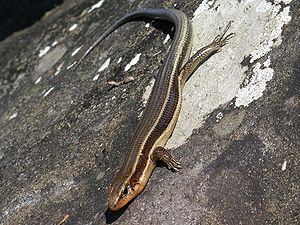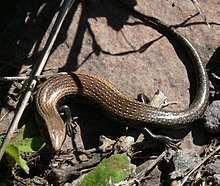Skinks
| Skinks | ||||||||||||
|---|---|---|---|---|---|---|---|---|---|---|---|---|

|
||||||||||||
| Systematics | ||||||||||||
|
||||||||||||
| Scientific name | ||||||||||||
| Scincidae | ||||||||||||
| Gray , 1825 |
The skinks (Scincidae) even skinks called, are a lizard family from the order of Squamata (Squamata).
There are more than 100 genera and over 1500 species . The skinks are the most species-rich family of lizards.
Way of life
Skinks inhabit tropical areas all over the world. They are most common in Southeast Asia. There they inhabit the ground by burying themselves, or trees where their tail serves as a climbing aid. The tree-dwelling species have small barbs on it. Some species can shed their tails in danger. He then twitches for a while and thereby confuses the enemies, so that the lizard has time to flee.
Like snakes , skinks move forward with undulating movements through their short extremities. In ground-dwelling species, the legs can also be completely absent.
Skinks are usually dark in color, but can also be very colorful. In New Guinea there are some species whose blood is green due to the high concentration of biliverdin . As a result, muscles, bones and mucous membranes also show a bright green.
Most skinks reach a size between 8 and 35 centimeters. But there are also exceptions that can be significantly larger.
The diet consists of insects and lizards, among other things. Larger species also feed on vegetarian food. Some lay eggs, but almost half of all species give birth to live young, so they are ovoviviparous or even, like the pine cone lizard in Australia, genuinely viviparous . Some species protect the nests or their hatched offspring.
Internal system



Seven subfamilies are distinguished, which should receive the rank of families at the suggestion of the herpetologists S. Blair Hedges and Caitlin E. Conn. In early 2014, Hedges also set up the families Ateuchosauridae (for Ateuchosaurus ) and Ristellidae (for Lankascincus and Ristella ). The previously classified three subfamilies Acontinae, Lygosominae and Scincinae have the status of superfamilies (Acontinoidea, Lygosomoidea and Scincoidea) in this classification according to Hedges. As a result, the extent of these groups remains largely the same, only with the Lygosomoidea there is a further subdivision into new families, the other two superfamilies each comprise only one family.
- Subfamily Acontinae
- Subfamily Egerniinae
- Bellatorias Wells & Wellington, 1984
- Corucia Gray, 1855
- Cyclodomorphus Fitzinger, 1843
- Egernia Gray, 1838
- Hemisphaeriodon Peters, 1867
- Liopholis Fitzinger, 1843
- Lissolepis Peters, 1872
- Bluetongue Skink ( Tiliqua Gray, 1825)
-
Helmskinke ( Tribolonotus Duméril & Bibron, 1839)
- Roach crocodile ( Tribolonotus gracilis )
- Subfamily Eugongylinae
- Subfamily Lygosominae
- Subfamily Mabuyinae
- Subfamily Sphenomorphinae
- Subfamily Scincinae
- Amphiglossus
- Androngo
- Barkudia
- Brachymeles
- Chabanaudia
- Roller skink ( Chalcides )
- Chalcidoseps
- Eumeces
- Eurylepis
- Feylinia
- Flexiseps
- Gongylomorphus
- Hakaria
- Janetaescincus
- Jarujinia
- Madascincus
- Melanoseps
- Mesoscincus
- Nessia
- Ophiomorus
- Pamelaescincus
- Paracontias
- Plestiodon
- Proscelotes
- Pseudoacontias
- Pygomeles
- Scelotes
- Scincopus
- Scincus
- Scolecoseps
- Sepsina
- Sepsophis
- Sirenoscincus
- Typhlacontias
- Voeltzkowia
literature
- Eric R. Pianka, Laurie J. Vitt: Lizards. Windows to the Evolution of Diversity (= Organisms and Environments. Vol. 5). University of California Press, Berkeley CA et al. 2003, ISBN 0-520-23401-4 .
- MG Gardner, AF Hugall, SC Donnellan, MN Hutchinson and R. Foster: Molecular systematics of social skinks: phylogeny and taxonomy of the Egernia group (Reptilia: Scincidae). Zoological Journal of the Linnean Society Vol. 154, 2008, 781-794.
Individual evidence
- ↑ Urania Tierreich, 1st ed. 1969, Bd Fish Lurche Kriechtiere, p. 433
- ^ Scincidae in The Reptile Database
- ^ S. Blair Hedges & Caitlin E. Conn: A new skink fauna from Caribbean islands (Squamata, Mabuyidae, Mabuyinae). Zootaxa 3288, April 30, 2012
- ↑ a b S. Blair Hedges: The high-level classification of skinks (Reptilia, Squamata, Scincomorpha). Zootaxa 3765 (4), pp. 317–338, February 19, 2014, doi: 10.11646 / zootaxa.3765.4.2
Web links
- Multiple origins of green blood in New Guinea lizards in Science Advances from May 16, 2018

